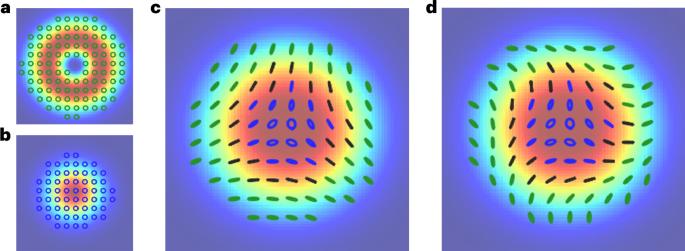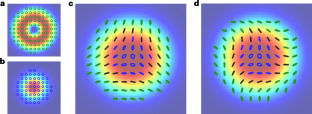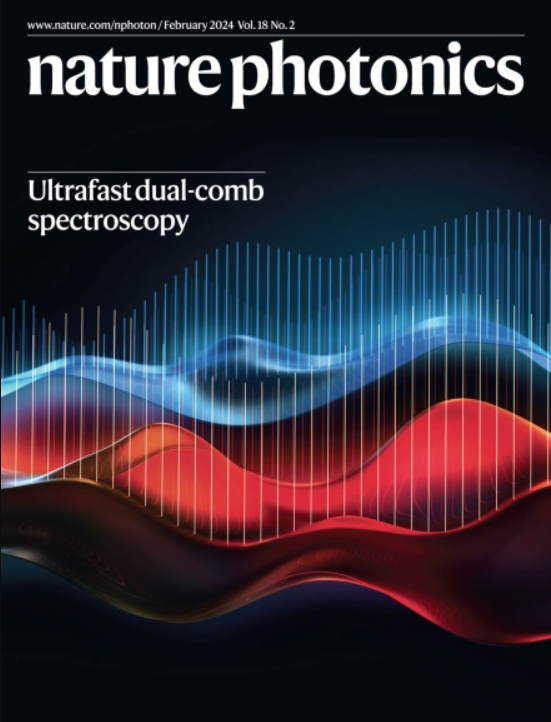从自由电子激光器发出的束
IF 32.9
1区 物理与天体物理
Q1 OPTICS
引用次数: 0
摘要
庞卡罗莱光束是具有空间非均匀偏振结构的光束,它跨越了庞卡罗莱莱球的有限部分。这一特性赋予了光束有趣的拓扑特性,并导致了对其基本特性,控制产生和新兴应用的研究激增。本文介绍了在费米自由电子激光器(FEL)上产生的极紫外(16.7 nm)庞加莱光束的实验演示。“星”型庞卡罗光束是利用FEL辐射固有的相位和强度结构产生的,而不依赖于光学元件。我们通过精确的重叠和功率平衡来控制空间偏振分布,每个脉冲具有不同的横向相位分布和正交圆偏振。对空间极化结构进行了详细的映射,显示了庞加莱球的广泛覆盖范围,与分析预测一致。这种在FELs中原位庞卡罗光束生产的方法可以在偏振态的方向和平衡上实现直接的灵活性,并且可以很容易地扩展到其他矢量光束和更短的波长,从而在现代光源中实现新的科学应用。本文章由计算机程序翻译,如有差异,请以英文原文为准。


Poincaré beams from a free electron laser
Poincaré beams are light beams that have spatially inhomogeneous polarization structure that spans a finite portion of the Poincaré sphere. This feature bestows the beams with intriguing topological properties and has led to a surge in research on their fundamental characteristics, their controlled generation and on emerging applications. Here we present an experimental demonstration of a Poincaré beam generated in the extreme ultraviolet (16.7 nm) at the FERMI free electron laser (FEL). The ‘star’ type Poincaré beam is generated by exploiting the phase and intensity structure intrinsic to FEL radiation without relying on optical elements. We controlled the spatial polarization distribution through a precise overlap and power balance between two FEL pulses, each with different transverse phase distributions and orthogonal circular polarizations. The spatial polarization structure was mapped in detail and shows extensive coverage of the Poincaré sphere, in agreement with analytic predictions. This method of in situ Poincaré beam production in FELs enables straightforward flexibility in the orientation and balance of polarization states, and can readily be extended to other vector beams and to shorter wavelengths enabling novel science applications in modern light sources. Researchers generated 16.7 nm wavelength extreme-ultraviolet Poincaré beams at the FERMI free electron laser without relying on optical elements. The method of in situ Poincaré beam production in free electron lasers enables straightforward flexibility in the orientation and balance of polarization states, and can be extended to other vector beams and to shorter wavelengths.
求助全文
通过发布文献求助,成功后即可免费获取论文全文。
去求助
来源期刊

Nature Photonics
物理-光学
CiteScore
54.20
自引率
1.70%
发文量
158
审稿时长
12 months
期刊介绍:
Nature Photonics is a monthly journal dedicated to the scientific study and application of light, known as Photonics. It publishes top-quality, peer-reviewed research across all areas of light generation, manipulation, and detection.
The journal encompasses research into the fundamental properties of light and its interactions with matter, as well as the latest developments in optoelectronic devices and emerging photonics applications. Topics covered include lasers, LEDs, imaging, detectors, optoelectronic devices, quantum optics, biophotonics, optical data storage, spectroscopy, fiber optics, solar energy, displays, terahertz technology, nonlinear optics, plasmonics, nanophotonics, and X-rays.
In addition to research papers and review articles summarizing scientific findings in optoelectronics, Nature Photonics also features News and Views pieces and research highlights. It uniquely includes articles on the business aspects of the industry, such as technology commercialization and market analysis, offering a comprehensive perspective on the field.
 求助内容:
求助内容: 应助结果提醒方式:
应助结果提醒方式:


